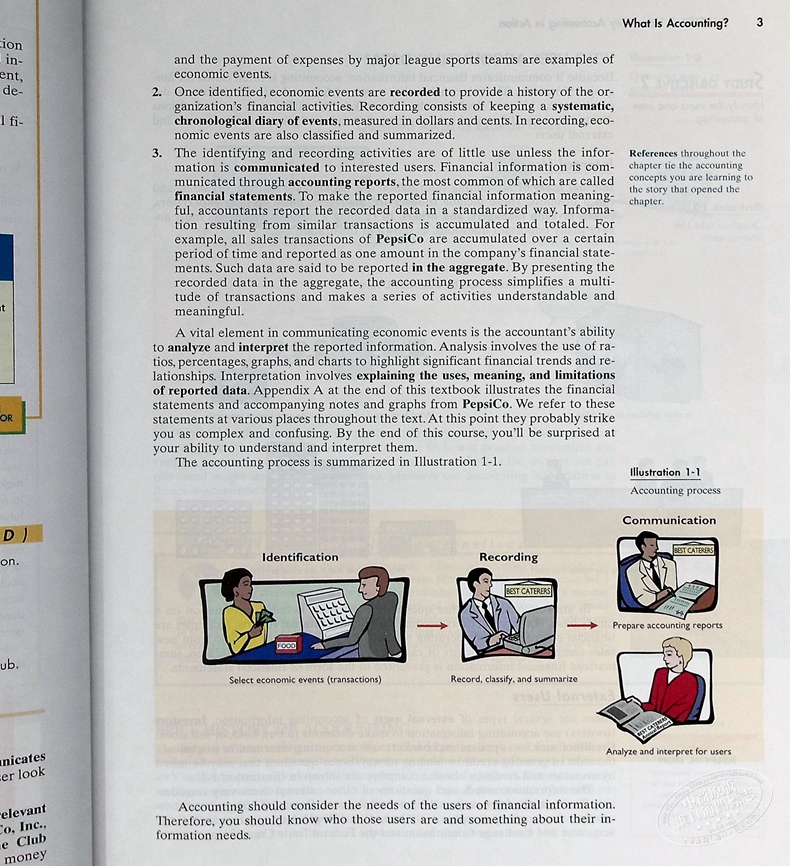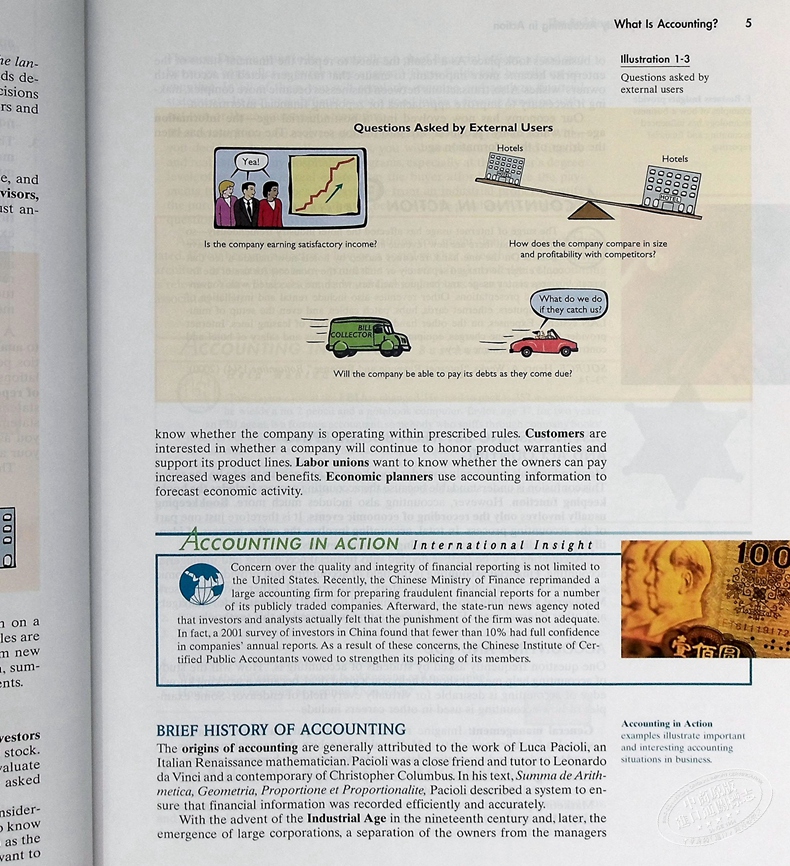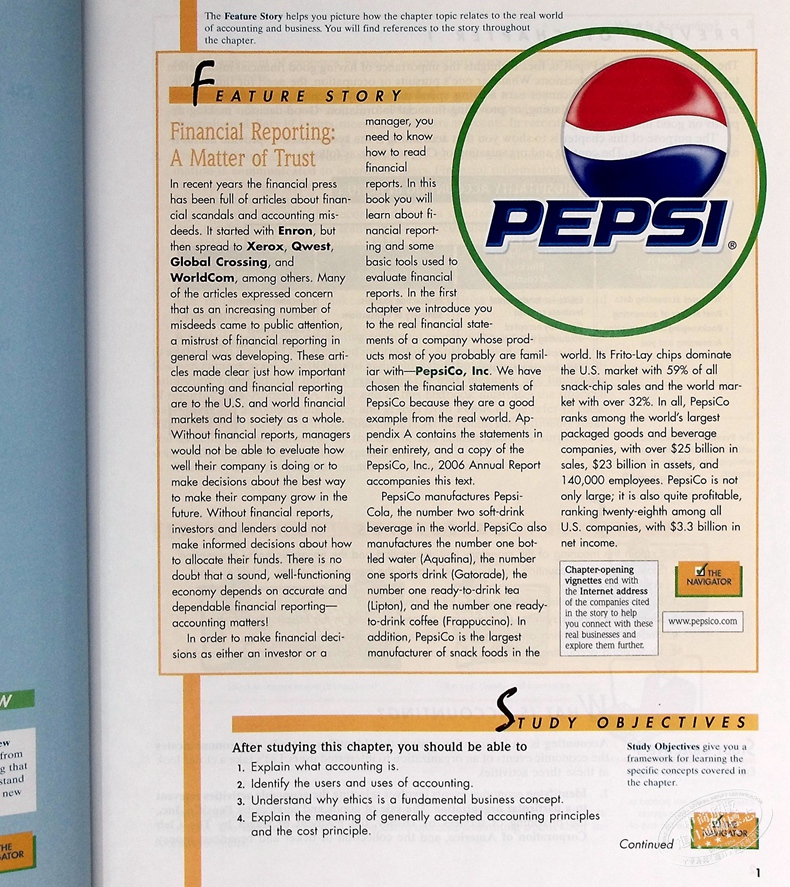Hospitality Financial Accounting, Second Edition
基本信息
Format:Hardback 544 pages
Publisher:John Wiley & Sons Inc
Imprint:John Wiley & Sons Inc
Edition:2nd Edition
ISBN:9780470083604
Published:13 Feb 2008
Classifications:Financial accounting, Hospitality industry
Readership:Professional & Vocational
Weight:1292g
Dimensions:284 x 220 x 23 (mm)
頁面參數僅供參考,具體以實物為準
書籍簡介
As the hospitality field continues to grow and diversify, today’s hospitality professionals need to understand financial accounting at a higher level than ever before. Written by some of the most respected authors in accounting, Hospitality Financial Accounting, Second Edition gives a complete introduction to financial accounting principles and demonstrates how to apply them to all facets of the hospitality industry.
Updated with the latest developments in the accounting and hospitality fields,Hospitality Financial Accounting, Second Edition covers the basics of financial accounting first and then shows hospitality students how to analyze financial statements and deal with the daily issues they will face on the job.
NEW TO THIS EDITION
Features a new dedicated chapter on financial statement analysis
Includes actual financial statements of PepsiCo are included and referred to throughout
New case studies cover a variety of hospitality enterprises doing business today
The view of the hospitality industry is expanded to such businesses as casinos, spas, and purveyors
Features an expanded section on ethics with real-world cases
Provides new Accounting in Action vignettes from hospitality and online companies support the concepts being discussed
Applied exercises that demonstrate the relevance of accounting to hospitality businesses
Appendices that discuss subsidiary ledgers and special journals
All end-of-chapter exercises have been revised and updated, and new ones added
FEATURES
Adapted from the market-leading textbook on financial accounting
Offers material on accounting and the hospitality industry, payroll, and the uniform system of accounts and financial reporting
Presents full-color interior with strong pedagogy, including Feature Stories, Chapter Objectives, Chapter Preview, Key Terms and Equations, Before You Go On practice problems, Technology box feature, and International Notes
Includes Demonstration Problems that give immediate practice, Financial Reporting Problems that use the PepsiCo financial statement, and Group Decision Cases that develop teamwork and group decision making skills
Features applied, user-oriented exercises that demonstrate the relevance of accounting to hospitality students
Includes scores of helpful drawings, charts, and tables
Utilizes a learning system called The Navigator that provides a checklist of the learning aides and study skills in each chapter, enabling students to set priorities and check their progress
Student website with review questions, self-study questions, and additional practice exercises
目錄
CHAPTER 1 HOSPITALITY ACCOUNTING IN ACTION 1
FEATURE STORY: Financial Reporting: A Matter of Trust 1
What Is Accounting? 2
Who Uses Accounting Data? 4
Brief History of Accounting 5
Distinguishing between Bookkeeping and Accounting 6
Accounting and You 6
The Building Blocks of Accounting 7
Ethics—A Fundamental Business Concept 8
Generally Accepted Accounting Principles 8
Assumptions 9
Basic Accounting Equation 11
The Accounting Cycle and the Flow of Information 14
The Uniform System of Accounts and Financial Reporting 15
Lodging Industry 16
Foodservice Industry 16
Club Industry 16
Spa Industry 16
Gaming Industry 17
Accounting and Financial Management in Hospitality 17
Hotel Operations 17
Hotel Accounting Department Organization 20
Foodservice Operations 22
Club Operations 23
Appendix The Accounting Profession 25
Public Accounting 26
Private Accounting 26
Not-for-Profit Accounting 26
CHAPTER 2 ACCOUNTING PRINCIPLES 30
FEATURE STORY: Certainly Worth Investigating! 31
The Conceptual Framework of Accounting 32
Objectives of Financial Reporting 33
Qualitative Characteristics of Accounting Information 34
Elements of Financial Statements 35
Operating Guidelines 36
Assumptions 36
Monetary Unit Assumption 37
Economic Entity Assumption 37
Time Period Assumption 37
Going Concern Assumption 37
Principles 37
Revenue Recognition Principle 38
Matching Principle (Expense Recognition) 38
Full Disclosure Principle 40
Cost Principle 40
Constraints in Accounting 41
Materiality 42
Conservatism 42
Summary of Conceptual Framework 42
Financial Statement Presentation—An International Perspective 43
Using the Building Blocks 44
Transaction Analysis 45
Summary of Transactions 50
Financial Statements 52
Income Statement 52
Retained Earnings Statement 52
Balance Sheet 54
Statement of Cash Flows 54
CHAPTER 3 THE RECORDING PROCESS 66
FEATURE STORY: No Such Thing as a Perfect World 67
The Account 68
Debits and Credits 69
Debit and Credit Procedures 69
Stockholders’ Equity Relationships 72
Expansion of the Basic Equation 73
The Accounting Cycle 73
Steps in the Recording Process 74
The Journal 75
The Ledger 77
The Recording Process Illustrated 81
Summary Illustration of Journalizing and Posting 87
The Trial Balance 88
Limitations of a Trial Balance 89
Locating Errors 91
Use of Dollar Signs 91
Electronic Data Processing 92
Comparative Advantages of Manual versus Computerized Systems 92
A Look into the Future 93
CHAPTER 4 ADJUSTING THE ACCOUNTS 102
FEATURE STORY: Timing Is Everything 103
Timing Issues 104
Selecting an Accounting Time Period 105
Fiscal and Calendar Years 105
Accrual- versus Cash-Basis Accounting 105
Recognizing Revenues and Expenses 106
The Basics of Adjusting Entries 107
Types of Adjusting Entries 108
Adjusting Entries for Prepayments 108
Adjusting Entries for Accruals 115
Summary of Basic Relationships 120
The Adjusted Trial Balance and Financial Statements 122
Preparing the Adjusted Trial Balance 122
Preparing Financial Statements 122
Alternative Treatment of Prepaid Expenses and Unearned Revenues 124
Prepaid Expenses 124
Unearned Revenues 126
Summary of Additional Adjustment Relationships 127
CHAPTER 5 COMPLETION OF THEACCOUNTING CYCLE 136
FEATURE STORY: Everyone Likes to Win 137
Using a Work Sheet 138
Steps in Preparing a Work Sheet 138
Preparing Financial Statements from a Work Sheet 141
Preparing Adjusting Entries from a Work Sheet 144
Closing the Books 144
Preparing Closing Entries 145
Closing Entries, Illustrated 147
Posting of Closing Entries 147
Preparing a Postclosing Trial Balance 149
Summary of the Accounting Cycle 150
Correcting Entries—An Avoidable Step 151
Classified Balance Sheet 154
Standard Classifications 154
Classified Balance Sheet, Illustrated 158
CHAPTER 6 FINANCIAL STATEMENTS 168
FEATURE STORY: Cash Is King 169
The Income Statement 170
Multiple-Step Income Statement 170
Single-Step Income Statement 174
Departmental Income Statement 175
Consolidated Income Statement 176
Classified Balance Sheet 176
Relationship between the Income Statement and the Balance Sheet 177
The Statement of Cash Flows: Purpose and Format 178
Purpose of the Statement of Cash Flows 178
Meaning of Cash Flows 179
Classification of Cash Flows 179
Significant Noncash Activities 180
Format of the Statement of Cash Flows 181
Usefulness of the Statement of Cash Flows 182
Preparing the Statement of Cash Flows 183
Indirect and Direct Methods 183
Indirect Method for Statement of Cash Flows 185
First Year of Operations—2008 185
Second Year of Operations—2009 189
CHAPTER 7 FINANCIAL STATEMENT ANALYSIS 204
FEATURE STORY: “Follow That Stock!” 205
Basics of Financial Statement Analysis 206
Need for Comparative Analysis 206
Tools of Financial Statement Analysis 207
Horizontal Analysis 207
Balance Sheet 208
Income Statement 208
Retained Earnings Statement 210
Vertical Analysis 210
Balance Sheet 210
Income Statement 211
Ratio Analysis 213
Liquidity Ratios 214
Profitability Ratios 217
Solvency Ratios 220
Summary of Ratios 221
Limitations of Financial Statement Analysis 222
Estimates 222
Cost 222
Alternative Accounting Methods 223
Atypical Data 223
Diversification of Firms 223
CHAPTER 8 ACCOUNTING FOR MERCHANDISINGOPERATIONS IN HOSPITALITY 232
FEATURE STORY: Selling Dollars for 85
Cents 233
Merchandising Operations 234
Operating Cycles 235
Inventory Systems 236
Recording Purchases of Merchandise 238
Purchase Returns and Allowances 240
Freight Costs 241
Purchase Discounts 241
Recording Sales of Merchandise 243
Sales Returns and Allowances 244
Sales Discounts 245
Completing the Accounting Cycle 246
Adjusting Entries 246
Closing Entries 247
Summary of Merchandising Entries 247
Work Sheet for a Merchandiser 248
Using a Work Sheet 248
CHAPTER 9 INVENTORIES AND COST OF GOODSCALCULATION 260
FEATURE STORY: $12,800 Worth of Blueberry Muffins! 261
Inventory Basics 262
Classifying Inventory 263
Determining Inventory Quantities 263
Inventory Accounting Systems 265
Periodic Inventory System 266
Recording Transactions 266
Recording Purchases of Merchandise 266
Recording Sales of Merchandise 267
Cost of Goods Sold 268
Determining Cost of Goods Purchased 268
Transfers In and Out 270
Food Cost Calculations 271
Beverage Cost Calculations 271
Income Statement Presentation 272
Inventory Costing under a Periodic Inventory System 273
Using Actual Physical Flow Costing— Specific Identification 273
Using Assumed Cost-Flow Methods—FIFO, LIFO, and Average Cost 274
Financial Statement Effects of Cost-Flow Methods 278
Using Inventory Cost-Flow Methods Consistently 280
Inventory Errors 281
Income Statement Effects 281
Balance Sheet Effects 282
Statement Presentation and Analysis 282
Presentation 282
Analysis 283
CHAPTER 10
INTERNAL CONTROL AND CASH 288
FEATURE STORY: Minding the Money in Moose Jaw 289
Internal Control 290
Principles of Internal Control 291
Limitations of Internal Control 296
Cash Controls 296
Internal Control over Cash Receipts 297
Internal Control over Cash Disbursements 300
Use of a Bank 302
Making Bank Deposits 302
Writing Checks 302
Bank Statements 304
Reconciling the Bank Account 305
CHAPTER 11 PAYROLL 318
FEATURE STORY: Payroll: A Manageable Cost in the Hospitality Industry 319
Payroll Defined 320
Internal Control of Payroll 320
Hiring Employees 321
Timekeeping 321
Preparing the Payroll 323
Paying the Payroll 323
Fair Labor Standards Act 323
Determining the Payroll 324
Gross Earnings 324
Payroll Deductions 325
Net Pay 327
Recording the Payroll 327
Maintaining Payroll Department Records 327
Recognizing Payroll Expenses and Liabilities 329
Recording Payment of the Payroll 329
Tipped Employees 330
Tip Reporting 331
Employer Payroll Taxes 336
FICA Taxes 336
Federal Unemployment Taxes 336
State Unemployment Taxes 337
Recording Employer Payroll Taxes 337
Filing and Remitting Payroll Taxes 338
CHAPTER 12 ACCOUNTING FOR RECEIVABLESAND PAYABLES 346
FEATURE STORY: Financing His Dreams 347
Accounts Receivable 348
Types of Receivables 348
Recognizing Accounts Receivable 349
Valuing Accounts Receivable 350
Disposing of Accounts Receivable 357
Credit Policies 360
The Credit Department 360
The Credit Policy before, during, and after the Event 360
City Ledger of a Hotel 361
Notes Receivable 361
Determining the Maturity Date 362
Computing Interest 363
Recognizing Notes Receivable 364
Valuing Notes Receivable 364
Disposing of Notes Receivable 364
What Is a Current Liability? 367
Notes Payable 367
Sales Tax Payable 368
Payroll and Payroll Taxes Payable 369
Unearned Revenues 371
Current Maturities of Long-Term Debt 371
CHAPTER 13 LONG-TERM ANDINTANGIBLE ASSETS 380
FEATURE STORY: Time to Relax 381
Long-Term Assets 383
Determining the Cost of Long-Term Assets 383
Land 384
Land Improvements 384
Buildings 384
Equipment 385
Depreciation 386
Revising Periodic Depreciation 394
Expenditures during Useful Life 395
Long-Term Asset Disposals 396
Intangible Assets 401
Patents 402
Copyrights 402
Trademarks and Trade Names 402
Franchises and Licenses 403
Goodwill 403
CHAPTER 1 4 SOLE PROPRIETORSHIPS,PARTNERSHIPS, ANDCORPORATIONS 410
FEATURE STORY: “Two All Beef Patties, Special Sauce, Lettuce, Cheese, Pickles, Onions on a Sesame Seed Bun” 411
Sole Proprietorships 412
Partnerships 413
Association of Individuals 413
Mutual Agency 413
Limited Life 414
Unlimited Liability 414
Co-ownership of Property 414
Advantages and Disadvantages of a Partnership 414
The Partnership Agreement 415
Formation of a Partnership 415
Division of Net Income or Net Loss 416
Partnership Financial Statements 419
The Corporate Form of Organization and Stock Transactions 420
Characteristics of a Corporation 420
Forming a Corporation 424
Corporate Capital 424
Accounting for Common Stock Issues 429
Accounting for Treasury Stock 432
Preferred Stock 436
Dividends 438
Cash Dividends 438
Stock Dividends 441
Entries for Stock Dividends 442
Effects of Stock Dividends 443
Stock Splits 443
Retained Earnings 445
Retained Earnings Restrictions 446
Prior Period Adjustments 447
Retained Earnings Statement 447
APPENDIX A
SPECIMEN FINANCIAL STATEMENTS: PepsiCo, Inc. 454
APPENDIX B
SUBSUDIARY LEDGERS AND SPECIAL JOURNALS 482
FEATURE STORY: Different Roads for Different Folks 483
Expanding the Ledger—Subsidiary Ledgers 484
Nature and Purpose of Subsidiary Ledgers 484
Example 485
Advantages of Subsidiary Ledgers 486
Expanding the Journal—Special Journals 487
Sales Journal 488
Cash Receipts Journal 490
Purchases Journal 495
Cash Payments Journal 496
Effects of Special Journals on the General Journal 498
Photo Credits 505
Index 507
作者簡介
Jerry J. Weygandt, Ph.D., C.P.A., is the Arthur Andersen Alumni Professor of Accounting at the University of Wisconsin–Madison.
Donald E. Kieso, Ph.D., C.P.A., is the KPMG Emeritus Professor of Accounting at Northern Illinois University.
Paul D. Kimmel, Ph.D., C.P.A., is an Associate Professor of Accounting at the University of Wisconsin–Milwaukee.
Agnes L. DeFranco, Ed.D., C.H.E., is a Professor in the Conrad N. Hilton School of Hotel and Restaurant Management at the University of Houston.



評論曬單